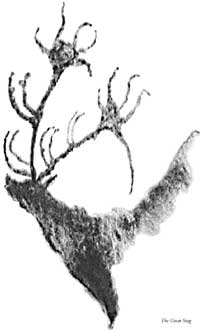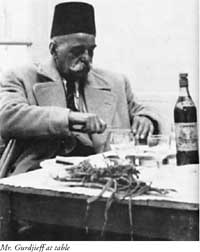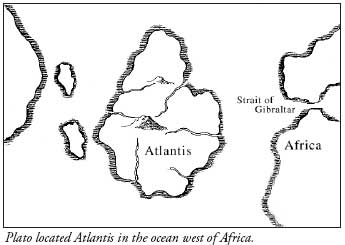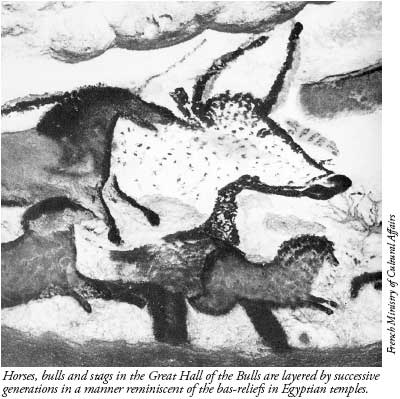Fourth Way Perspectives
Gurdjieff at Lascaux
August 1949
 Dying of cancer, Gurdjieff visited the caves of Lascaux, his last wish. The prehistoric art he saw there—was it an Atlantean legominism?
Dying of cancer, Gurdjieff visited the caves of Lascaux, his last wish. The prehistoric art he saw there—was it an Atlantean legominism?
Two months before Mr. Gurdjieff's death he made his last auto excursion to visit the prehistoric caves of Lascaux. In effect, it was his last wish. Discovered by chance in 1940, just after the German occupation of France, Lascaux had been opened to the public only in 1948. J. G. Bennett had visited the caves then and when he and Gurdjieff met soon after, Bennett told him of the spectacular and mysterious paintings and etchings on the walls. Despite Gurdjieff's increasing infirmity, his swollen legs and gaz—said Bennett, "He looked much older and moved with greater difficulty than when I had come to Paris the year before"—Gurdjieff insisted on making the trip.
Gurdjieff's Last Journey Begins
And so on the morning of August 31, 1949, Gurdjieff, "smoking a cigarette in a big black holder, with his red fez at a jaunty angle on the back of his head and a pocketbook bulging with thousand-franc notes," left Paris in a car loaded with students and hampers of food. Two more carloads of Gurdjieff's students followed.
"We left at 9 in the morning," wrote Elizabeth Mayall in her diary, "and had a marvelous drive through Clermont-Ferrand and by the Puy de Dôme to Montdoré. I thought it very beautiful. Mr. Bennett's car led. Five people [who had taken a train] had hired a car at Vichy in order to come too. We stopped at Montdoré for lunch [and] went on to Montignac." The party made the 400 mile trip from Paris to the village of Montignac, near the caves in the Dordogne region in the south of France, in 12 hours, arriving at 9 in the evening.

They dined at Le Relais du Soleil d'Or, Montignac's fanciest hotel, where Bennett had made reservations. Tired, his legs swelling, Gurdjieff talked little. He did speak about religion, saying that while Roman Catholicism had degenerated entirely, the Eastern Orthodox Church had retained at least something. About midnight, he finally retired. Though Gurdjieff seemed no better the next morning, he insisted on going to the caves and, according to Elizabeth Mayall, "seemed even anxious to see them." About 10 in the morning Gurdjieff descended into the series of chambers which extend deep into the hillside. There he saw the paintings of various animals, most spectacularly those of deer and bulls. At the time these were the richest known specimens of prehistoric art.
An Emblem like the Sphinx
Said Elizabeth Mayall: "I remember him standing with his feet apart, leaning on his stick, with his head thrown back, looking up at the Great Stag with the stylized antlers in the first gallery." Inspecting the paintings, Gurdjieff told his students they were the work of "a brotherhood that existed after the loss of Atlantis seven or eight thousand years ago," likely a reference to the society Akhaldan.
"As he stood looking at the paintings," said J. G. Bennett, "he seemed completely to belong there. He explained various symbols, and especially the painting of a strange composite animal, which he said was like the Sphinx, the 'emblem' of an esoteric society."

Bennett asked if he meant "symbol."
"No. Emblem," Gurdjieff declared. "At that time there were societies with special knowledge, and each society had an emblem by which the members recognized each other. Same way as we have Enneagram."
He implied, according to Bennett, that Lascaux was the center of an esoteric society and that the Great Stag was not only its emblem but its reminding factor for its work. The horns on the reindeer, he said, are like Beelzebub's horns. The number of points on the antlers represented the degree of attainment of the man. (He elaborates upon these degrees in the First Series.)
On the way to the caves after leaving Paris, and during and between meals, Gurdjieff had spoken about the "Inner God," saying, "If you learn to obey Inner God, this is a thousand times better than the Ten Commandments, which only tell us how to live, but cannot help man to work." Later he spoke about immortality. "Unmortal is a very big thing, but is not all. If a man works he can become of use even to God." He then pointed to Bennett and added: "There are two kinds of unmortal. He now has already Kesdjan body. This is unmortal, but not real unmortal. Real unmortal only comes with higher body. He have body for soul—but must also have body for 'I'."
Describing the difference between Paradise and the Sun Absolute, Gurdjieff noted: "You can go to Paradise with Kesdjan body. But Paradise is only good for two or three days. Imagine what it would be next year, year after, hundred years. Must not be satisfied with Paradise—must find way to Soleil Absolu."
To grow antlers or horns one must have more than a physical, or carnal, body. The higher the reason, the higher the body one must have attained, for the body is the support of reason. In Russia 1915–1917 Gurdjieff spoke of the crystallization of these bodies, designating them as carnal, natural, spiritual and divine bodies. Considering the context—that Gurdjieff is on his way to see the caves at Lascaux and that he realized the end of physical life was drawing near for him—his words take on an added weight.
How Old Are the Paintings?
Viewing the paintings on the cave walls, Gurdjieff said they were 8,000 years old. Here he might only have been speaking of the years before the birth of Jesus Christ and not including the two thousand years after. If so, the paintings would be some 10,000 years old.
Bennett reminded him that experts dated the paintings to 18,000 to 20,000 years. Gurdjieff wouldn't hear of it. "He insisted," said Bennett, "that this work was done after the loss of Atlantis."
Bennett told him that the evidence from the implements and bones in the cave showed that the paintings "go back before the time of the loss of Atlantis."
According to Bennett, "Gurdjieff immediately replied in a rather shocked tone, 'How can that be? These cannot be before the loss of Atlantis.' He then remained silent and I could get no more out of him."
When the group collected by the cars in front of the caves, Gurdjieff instructed Bennett to drive in another car. Then on the way back to Paris at Tulle, without any ceremony, he told Bennett: "I go left; you go right."
"Then we must say goodbye to you," answered Bennett. "Yes, goodbye!" Could what Gurdjieff is saying to Bennett relate to Bennett's denial of Gurdjieff's date for the Lascaux paintings?
As can be seen from Gurdjieff's comments at Lascaux and his First Series, the destruction of Atlantis is a pivotal event for him. The only historic accounts of Atlantis occur in Plato's Timaeus and in his Critas in which an Egyptian priest tells the famous Greek statesman Solon: "There have been and will be many different calamities to destroy mankind, the greatest of them by fire and water, lesser ones by countless other means....You remember only one deluge, though there have been many...." Evidence suggests that the deluge the priest refers to occurred around 9,600 B.C. writes Mary Settegast in her book Plato Prehistorian. Further, she believes that "The wave of inexplicably sophisticated settlers that appeared in the Near East in the last half of the eighth millennium B.C., may actually have been refugees from Plato's ruined cultures in the west."
Plato's Atlantis

Plato gives a date of 10,000 b.c. for the deluge; the most compelling evidence for this date,
Settegast says, is "simply the number and nature of the newly founded settlements that appeared in the
east around 7,500 to 7,300 b.c. From Syria to Palestine to east Anatolia and the Zagros mountains, extraordinarily
advanced communities emerged, seemingly out of nowhere. An inventory of their collective remains shows that
virtually all of the elements upon which the civilizations of later ages would be based—complex hybrid grains,
advanced architectural techniques, functional pottery, even the beginnings of metal work—were introduced almost
simultaneously by this wave of new settlers." We also see this later with the fullbodied emergence of the ancient Egyptian
culture in 3,000 b.c. Bennett also maintained that "Gurdjieff associated Atlantis with pre-sand Egypt..."
Speaking of Atlantis, the Egyptian
priest said: "There was an island opposite the strait [of Gibraltar]... an island larger
than Libya and Asia combined.... On this island of Atlantis had arisen a powerful
and remarkable dynasty of kings, who ruled the whole island, and many other
islands as well, and parts of the continent. In addition, it controlled, within the
strait, Libya up to the borders of Egypt and
Europe as far as Tyrrhenis [Italy]. This dynasty, gathering its whole power
together, attempted to enslave, at a single stroke, your country and ours and the territory
within the strait." [Emphasis added] Given that the Atlanteans had conquered Europe as far as Italy would mean
that they might know of and use the caves of Lascaux. From Gurdjieff's viewpoint
then, he is eyewitness to the paintings and etchings of the Atlanteans after their
Atlantean island homeland was swallowed up in the deluge of 9,600 b.c.
Could the paintings have been the work of survivors of the cataclysm as a means
of preserving their knowledge? In other words, are the paintings the Legominism of the Atlanteans?
The Atlanteans were rich, powerful and technologically advanced, according to Plato's Critas:
For many generations, so long as the
divine element in their nature survived, they observed the laws and loved the
divine to which they were akin. They retained a certain greatness of mind,
and treated the vagaries of fortune and one another with wisdom and forbearance,
as they reckoned that qualities of character were far more important than
their present prosperity. So they bore the burden of their wealth and possessions lightly, and did not let their high
standard of living intoxicate them or make them lose their self-control, but
saw soberly and clearly that all these things flourish only on a soil of common
goodwill and individual character, and if pursued too eagerly and overvalued
destroy themselves and morality with them. So long as these principles
and their divine nature remained unimpaired the prosperity which we have
described continued to grow. But when the divine element in them
became weakened by frequent admixture with mortal stock, and their human
traits became predominant, they ceased to be able to carry their prosperity with
moderation. To the perceptive eye the depth of their degeneration was clear
enough, but to those whose judgment of true happiness is defective they seemed,
in their pursuit of unbridled ambition and power, to be at the height of their fame and fortune.
The Circle Completed

In the tenth millennium, the Egyptian priest told Solon, a war broke out between
the Atlantic maritime empire of the Atlanteans and the Athenians. The Athenians were
able to check the advances of the Atlanteans, but both were overwhelmed, for: "At a
later time there were earthquakes and floods of extraordinary violence, and in a
single dreadful day and night all your fighting men were swallowed up by the earth,
and the island of Atlantis was similarly swallowed up by the sea and vanished."
And so, from this point of view, at Lascaux the circle of Gurdjieff's
life is completed. Is this why he is spoken of before entering the caves as "seeming anxious"?
His mature life began with a question:
What is the sense and significance of life on earth and human life in particular?
Believing that the esoteric societies of ancient civilizations held
the answer, he traveled to many remote and dangerous areas. Finally,
he discovered the origin of esoteric knowledge in ancient Egypt,
"only not from the one that we know but from one which we do not know.
This Egypt was in the same place as the other but it existed much earlier,"
he said. Realizing that over time elements of the teaching had migrated northward,
he sought out these elements and then reassembled and reformulated them for contemporary
mentality. To differentiate the teaching from the three well-known classical ways—
that of the Hatha yogi, the monk and the Raja yogi—he called it the Fourth
Way, the way of self-transformation in ordinary life. As he said, "The
religions of the West have degenerated to such an extent that for a long time there
has been nothing alive in them. Various occult and mystical societies and naïve
experiments in the nature of spiritualism, and so on, can give no results whatever.
And the position would indeed be hopeless if the possibility of yet a fourth way
did not exist. The fourth way requires no retirement into the desert, does not require
a man to give up and renounce everything by which he formerly lived. The fourth
way begins much further on than the way of the yogi [way of the mind]."
Earlier, having recognized that "Unless the 'wisdom' of the East and the
'energy' of the West could be harnessed and used harmoniously, the world would
be destroyed," Gurdjieff took upon himself the mission to bring this ancient
teaching of the Fourth Way to the West. That was in 1912. Now at Lascaux, just
months before his Rascooarno, he was present to a Legominism whose essence
lay in the symbols and their vibrations of the true origin of esoteric knowledge—the Atlanteans.
Just eight days before his death, Gurdjieff saw the first publisher's proofs
of his Legominism, the First Series of All and Everything. As he had said earlier—"I now very
tired and I know that when I finish this last book my work will be
done. So now I can die, because my task in life is coming to an end."
Notes
1. We left at 9 in the morning. See J. G. Bennett and Elizabeth Bennett, Idiots in Paris: Diaries of
J. G. Bennett and
Elizabeth Bennett, 1949 (York Beach, Maine: Samuel Weiser, 1991), pp. 51–52. At the time the diaries were written,
Bennett's wife Winifred Alice Bennett was still living. Within three
months of her death, on July 25, 1957, he married Elizabeth Howard, née Mayall.
2. At the time. In September 2000, at a cave near Perigueux in the Dordogne region, prehistoric art was discovered
which archaeologists date back some 30,000 years. The Cussac cave walls
show hundreds of yards of detailed and well-preserved images of animals
including bison—one twelve feet long—horses, rhinoceroses and human figures.
3. A brotherhood. See J. G. Bennett, Gurdjieff: Making a New World (New York: Harper & Row, 1973), p. 87.
See also, "Returning to the Source," Telos, vol. 3, no. 4.
4. Degree of attainment. See J. G. Bennett,
Witness: The Autobiography of John G. Bennett (Tucson, Ariz.: Omen Press, 1974), pp. 264–65.
5. Inner God. Ibid., p. 264.
6. Designation of bodies. See P. D. Ouspensky, In Search of the Miraculous, p. 41.
7. Loss of Atlantis. See Bennett, op cit., p. 55.
8. Implements and bones. In themselves,
these do not prove the date of the paintings, only that there were people there 18,000–20,000 years ago.
9. I go left, you go right. Gurdjieff's designation
of direction may have an inner meaning as can be seen in the First Series.
10. Different calamities. See
Plato's Timaeus and Critas (New York: Penguin, 1977), p. 35.
11. The wave of. See Mary Settegast, Plato, Prehistorian (Hudson, N.Y.: Lindisfarne Press, 1990), p. 9.
12. Simply the number and nature. Ibid., p. 67.
13. Atlantis and pre-sand Egypt. See Bennett, op. cit., p. 86.
14. There was an island. Ibid., pp. 37–38.
15. When the divine element. Ibid., p. 145. The parallel with contemporary America is instructive.
16. Mortal stock. There were some mortals
living on Atlantis when the Atlanteans
appeared. As Plato relates in the
Timaeus, pp. 122–23: "The men of the first generation who lived cowardly or
immoral lives were, it is reasonable to suppose, reborn in the second generation
as women; and it was therefore at that point of time that the gods produced
sexual love.... A man's genitals are naturally disobedient and self-willed, like a
creature that will not listen to reason, and will do anything in their mad lust
for possession. Much the same is true of the matrix or womb of women, which is
a living creature within them which longs to bear children. And if it is left
unfertilized long beyond the normal time, it causes extreme unrest, strays about the body, blocks the channels of
the breath and causes in consequence acute distress and disorders of all kinds."
17. Origin of esoteric knowledge. According to Gurdjieff's First Series,
the terrestrial origin of esoteric knowledge is Beelzebub's tribe,
which was centered in Atlantis. They had relations with an esoteric society
of Atlanteans, the Society of Akhaldans. Intuiting the coming deluge,
Beelzebub's tribe departed for Ethiopia. Surviving members of the Society of Akhaldans made their way
to Ethiopia. Beelzebub's tribe advised them to reside in Egypt, which they
did. They were the foundation of the ancient Egyptian civilization. See
William Patrick Patterson's video Gurdjieff in Egypt: The Origin of Esoteric Knowledge.
18. I now very tired. See Fritz Peters, Gurdjieff Remembered (York Beach, Maine: Samuel Weiser, 1971), p. 110.